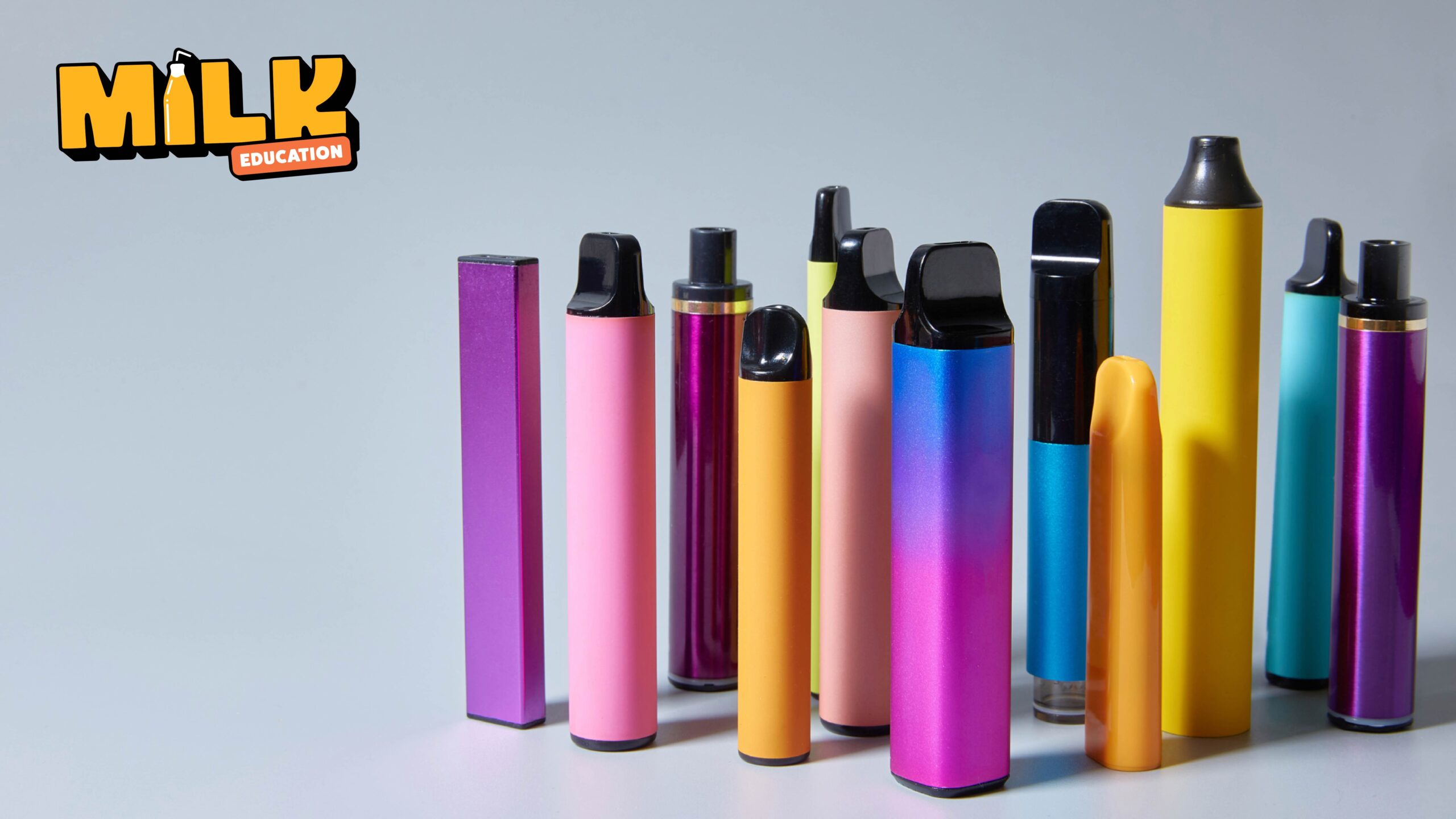As a teacher, I know that trends come and go in schools. One ‘trend,’ however, seems to have stuck around – and it feels like it isn’t going away anytime soon.
Vaping. Students are drawn to vaping for many reasons, but the bright colours and sweet flavours of disposable vapes are dangerously appealing to young people.
According to a 2023 study from Action on Smoking and Health (ASH), 20.5% of children aged 11 to 17 have tried vaping. This is a prevalent issue in schools across the U.K., with many teachers struggling to tackle this on top of an already busy workload.
What role do school staff play in preventing and stopping students from vaping in schools?
Let’s talk about it.
Facts About Vaping
Vaping Laws in the U.K
- It is illegal to sell nicotine vaping products to under 18s, or for adults to buy them on behalf of anyone under the age of 18.
- You can report a retailer to the local authority Trading Standards, if you believe they are selling nicotine or tobacco products to under 18s.
- Under 18s who are found to be vaping will not face any legal action, but schools should provide an appropriate consequence.
What are the Dangers of Vaping?
The long-term effects of vaping are still not fully known.
However, there is evidence highlighting the impact of vaping on both physical and mental health.
Although e-cigarettes are often used by adult cigarette smokers to help them quit, which is recommended as a positive alternative by the NHS, the majority of young people are instead choosing to vape because ‘other people do it’ and they ‘like the flavours.’
- Addiction: All e-cigarettes typically contain nicotine in varying amounts, which is highly addictive. Vapes that are described as “nicotine-free” have even been found to contain nicotine. Addiction can lend to increased spending, lower academic performance, and a reliance on vaping to deal with stressful situations.
- Asthma: Vaping can irritate your airways, causing an increased likelihood of asthma attacks, and can impact the lung’s ability to fight infection.
- E-Cigarette or Vaping Use-Associated Lung Injury (EVALI): This is a serious condition which results in sudden and severe lung issues related to vaping use. In 2020, more than 2,800 people were admitted to hospital with EVALI, and 68 of those people unfortunately died.
- Explosions and Burns: The charging devices used for many e-cigarettes have been reported to have battery issues, which have led to explosions and burns. This can cause permanent scarring or more severe injuries.
- Damage to the Environment: Disposable vapes should never be thrown away in general waste, as damaged batteries can cause fires. If not discarded properly, these products can break down and release pollutants into the air. They should be recycled at a shop or household waste recycling centre.
- Gateway to Other Drugs: The addictive properties of nicotine and peer pressure from others can cause young people to turn to smoking tobacco cigarettes and other, more dangerous substances.
How to Stop Students Vaping in School
Not sure what to do about vaping in schools? I know it’s difficult, but here are five easy-to-action tips that helped me when I was teaching.
- Raise Awareness with Engaging Lesson Plans
- Communication is Key
- Appropriate Action and Alternative Outlets
- Vape Detectors
- Get to Know Social Media Trends
1. Raise Awareness with Engaging Lesson Plans
A study from Action on Smoking and Health (ASH), found that 54% of young people aged between 11 and 18 started vaping “just to give it a try.”
Teaching students about the consequences can deter them from trying it in the first place.
Activity-based learning, engaging stories and imagery can help to create a discussion about vaping and peer pressure with your students.
The classroom should be a safe space for students to discuss their feelings about vaping, but also any safeguarding concerns should be raised with the Safeguarding Lead in your school immediately.
To help raise awareness about vaping, I’ve created a free vaping lesson plan, suitable for KS3 & 4, for you to adapt and use with your students. Register with us today for access to this and more PSHE lesson plans.
2. Communication is Key
If you notice that a student is vaping in school, or even selling and purchasing vapes, you should report this to the Safeguarding Lead in your school, who will then contact parents or guardians accordingly.
Sending out letters to all parents or guardians, or alerting them via the school’s social media, can be useful if you notice that there’s an increase in vaping.
Informing parents and guardians creates a conversation and lets you know how they are working towards preventing this at home, too. Parents Evenings are a great opportunity to bring this up with all parents in some way, and you can also provide resources to parents, such as information and support groups.
3. Appropriate Action and Alternative Outlets
Your school policy should outline the appropriate action to take if a student is caught vaping on school premises, or selling vapes to other students.
Some schools choose to exclude students for this behaviour, but it’s arguable whether this approach gets to the root of the vaping problem.
It’s worth considering whether exclusion could be part of a ‘three strike’ rule, as opposed to an immediate exclusion after a first offence. Detentions can potentially work as more of a deterrent against vaping in the long-term, as well as short courses that help students to stop.
Students should be made aware of possible peer pressure situations, and any bullying related to vaping should be dealt with immediately.
Alternatives outlets for stress relief, such as encouraging students to participate in sports or art clubs can help to reduce the appeal of vaping.
4. Vape Detectors – Do They Work?
Vape Detectors track any instances of vaping, alerting schools where and when vaping is taking place on their premises.
Some schools have reported great success with Vape Detectors. One headteacher used a combination of CCTV and Vape Sensors to pinpoint exact locations where students were vaping, and this decreased cases of vaping in the school from 16 on the first day, down to one or two a week.
Although they don’t directly address the root cause of vaping, Vape Detectors bring attention to students who are vaping, preventing hidden activity, and making vaping less of an issue on school premises.
Whilst they can be pricey, typically upwards of £1000, they can be a worthwhile investment if there is a school-wide issue with vaping.
Installing cameras and monitoring areas where vaping has occurred in school can also act as a useful deterrent and prevent students from disappearing from lessons to vape, as they know they won’t be able to hide it easily.
Get to Know Social Media Trends
A 2024 British Medical Journal study found that young people who use social media more frequently were more likely to smoke or vape.
Researchers found that ‘direct advertising’ based on algorithms, and ‘paid influencers who present smoking and vaping as a fashionable and desirable activity’ were key things that young people were exposed to on social media, leading to increased vape usage.
If you use social media, take a moment to scroll through hashtags related to vaping on platforms such as Instagram and TikTok to gain an insight into what young people are being exposed to.
Being aware of current social media trends related to vaping can help staff to highlight these issues in the classroom. Encouraging students to follow positive influencers, such as our School Speakers (The Milkfluencers), can help to change their mindset towards vaping.
Our partnership with Make Life Kind Charity gives us access to incredible school speakers, including speakers such as Hermen Dange. Hermen discusses his experiences with gang culture and the consequences of drug crime, which vaping can be an unfortunate gateway into. Hermen’s interactive talk highlights how drugs are not ‘cool’ and the real impact of peer pressure. Register with us to discuss how we can book Hermen or our other Milkfluencers to speak in your school.
Play Your Part in Stopping the Vaping Crisis
Undoubtedly, there is a vaping crisis in schools across the U.K. right now, but you can play your part in tackling it.
Even if you deter one student from vaping, this will make a huge difference and could potentially save them from moving on to more harmful substances.
Is vaping a big problem in your school? Do you have any other tips to tackle it?
Let us know in the comments!

